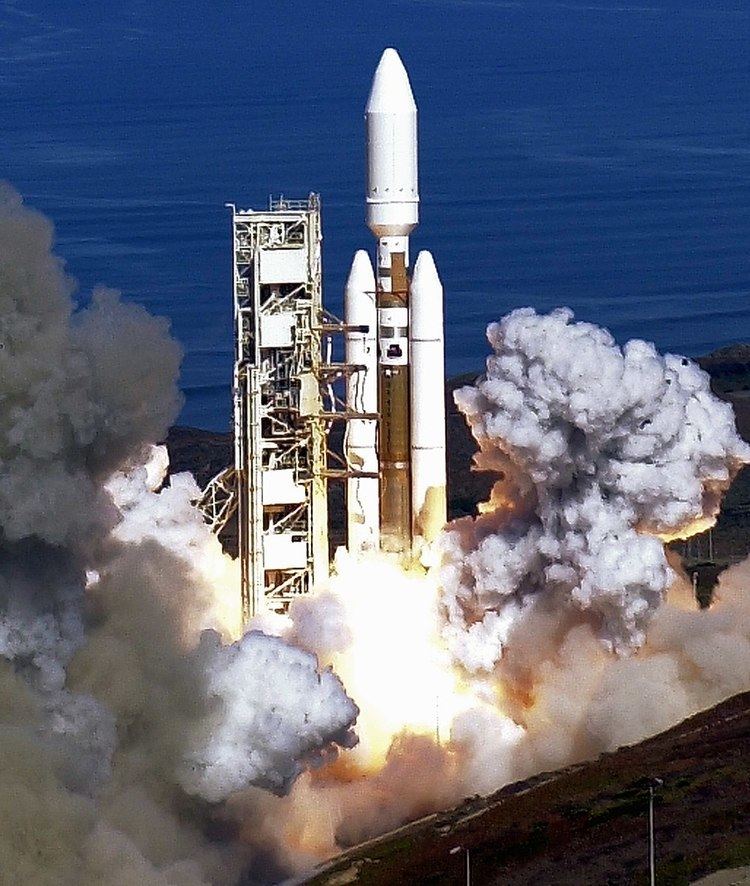Short name SLC-4 Launch site Vandenberg Air Force Base Launch pad 2 | Min / max
orbital inclination 51° – 145° Phone +1 321-853-1919 Total launches 163 | |
 | ||
Location 34.632706°N
120.613393°W Operator US Air Force
SpaceX (4E from 2011) Status Being converted to a landing pad for Falcon 9 First launch 12 July 1963
Atlas-Agena D / OPS-1467 Address Vandenberg Air Force Base, Lompoc, CA 93436, USA | ||
Space Launch Complex 4 (SLC-4) is a launch and landing site at Vandenberg Air Force Base with two pads, both of which are used by SpaceX for Falcon 9 launch operations.
Contents
- Atlas Agena
- Titan IIID
- Titan 34D
- Titan IV
- Falcon
- Titan IIIB
- Titan 23G
- Falcon 9 and Falcon Heavy landing pad
- References
The complex was previously used by Atlas and Titan rockets between 1963 and 2005. It consisted of two launch pads, SLC-4W and SLC-4E, which were formerly designated PALC2-3 and PALC2-4 respectively. Both pads were built for use by Atlas-Agena rockets, but were later rebuilt to handle Titan rockets. The designation SLC-4 was applied at the time of the conversion to launch Titans.
Both pads at Space Launch Complex 4 are currently leased by SpaceX. SLC-4E is leased as a launch site for the Falcon 9 rocket, which first flew from Vandenberg on 29 September 2013, following a 24-month refurbishment program which had started in early 2011. SpaceX began a five-year lease of Launch Complex 4 West in February 2015 in order to use that area as a landing pad to bring back VTVL Return-To-Launch-Site (RTLS) first-stage boosters of the reusable Falcon 9 and Falcon Heavy launch vehicles.
Atlas-Agena
The first launch from PALC2-4 occurred on 14 August 1964, when a KH-7 satellite was launched by an Atlas-Agena D. After 27 Atlas-Agena launches, the last of which was on 4 June 1967, the complex was deactivated.
Titan IIID
During 1971 the complex was reactivated and refurbished for use by the Martin Marietta Titan III launch vehicles. The Titan IIID made its maiden flight from SLC-4E on 15 June 1971, launching the first KH-9 Hexagon satellite. The first KH-11 Kennan satellite was launched from the complex on 19 December 1976. All 22 Titan IIIDs were launched from SLC-4E, with the last occurring on 17 November 1982.
Titan 34D
The complex was then refurbished to accommodate the Martin Marietta Titan 34D. Seven Titan 34Ds were launched between 20 June 1983, and 6 November 1988. SLC-4E hosted one of the most dramatic launch accidents in US history when a Titan 34D carrying a KH-9 satellite exploded just above the pad on April 18, 1986. The enormous blast showered the launch complex with debris and toxic propellant, resulting in extensive damage. 16 months after the accident, the pad was back in commission when it hosted a successful launch of a KH-11 satellite.
Titan IV
The last type to use the complex was the Titan IV, starting on 8 March 1991, with the launch of Lacrosse 2. On 19 October 2005, the last flight of a Titan rocket occurred, when a Titan IVB was launched from SLC-4E, with an Improved Crystal satellite. Following this launch, the complex was deactivated, having been used for 68 launches.
Falcon
SpaceX refurbished SLC–4E for Falcon 9 and Falcon Heavy launches, in a 24-month process that began in early 2011. The draft environmental impact assessment with a finding of "no significant impact" was published in February 2011. Demolition began on the pad's fixed and mobile service towers in summer 2011.
By late 2012, SpaceX continued to anticipate that the initial launch from the Vandenberg pad would be in 2013, but would be a Falcon 9 launch—actually, a heavily modified and much larger Falcon 9 v1.1. As the pad was nearing completion in February 2013, the first Falcon 9 launch was scheduled for summer 2013, but was delayed until September 2013. Falcon 9 flights flown are shown in the launch history below.
Atlas-Agena
The first launch to use what is now SLC-4 occurred on 12 July 1963, when an Atlas LV-3 Agena-D launched the first KH-7 Gambit reconnaissance satellite, from PALC2-3. Twelve Atlas-Agenas launches were conducted from PALC2-3, with the last occurring on 12 March 1965.
Titan IIIB
Following this, it was rebuilt as SLC-4W, a Titan launch complex. The first Titan launch from SLC-4W was a Titan IIIB, on 29 July 1966. All 70 Titan IIIB launches occurred from SLC-4W, with the last on 12 February 1987.
Titan 23G
After the retirement of the Titan IIIB, it became a Titan 23G launch site, and twelve Titan II launches, using the 23G orbital configuration, were conducted between 5 September 1988 and 18 October 2003. Following the retirement of the Titan 23G, SLC-4W was deactivated. 93 rockets were launched from SLC-4W.
SLC-4W was the site of the launch of Clementine, the only spacecraft to be launched from Vandenberg to the Moon, which was launched by a Titan 23G on 25 January 1994.
Falcon 9 and Falcon Heavy landing pad
SpaceX signed a five-year lease of Launch Complex 4W in February 2015, in order to use the area to land reusable launch vehicles at the pad. The location will be used for vertical landing of Return-To-Launch-Site (RTLS) first-stage boosters of the Reusable Falcon 9 (F9R) and Falcon Heavy launch vehicles that are launched from SpaceX-leased launch pads at the adjacent SLC 4E launch pad.
This novel use of SLC 4W had initially surfaced in July 2014 when NASASpaceFlight.com published that SpaceX was considering leasing SLC-4W for use as a RTLS vertical-landing facility for reusable first-stage boosters of the F9R and Falcon Heavy launch vehicles that would be launched from SLC-4E.
Principal structures on the pad were demolished in September 2014 as refurbishment began.
SpaceX has also signed a lease for an east coast RTLS landing pad—called Landing Zone 1—at Cape Canaveral Air Force Station.
